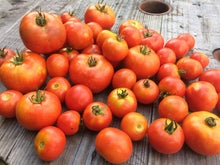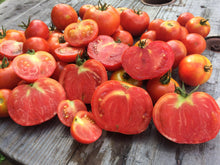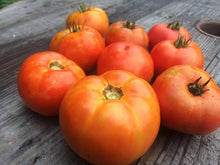'Rutgers 250 Schermerhorn' Tomato
Regular price
$4.00
Sale
Solanum lycopersicum
Origin: New Jersey
Improvement Status: Cultivar
Seeds per packet: ~30
Germination tested 10/2025: 79%
Life cycle: Annual
Habit: Indeterminate
EFN EXCLUSIVE. This is a "new heirloom" released in 2016 by Rutgers University as an homage to the original 'Rutgers' tomato, which has been the very definition of the term "Jersey tomato" since the 1930s. The story actually begins at the Campbell's Soup Company in 1928. Based in Camden, NJ, Campbell's has long had an active and impressive plant breeding program, and it was in 1928 that someone working for Campbell's crossed a sour-tasting but disease-resistant tomato called 'J.T.D' (after John T. Dorrance, who thought up Campbell's condensed soups) with a sweet, popular, but disease-susceptible tomato called 'Marglobe.' Soon after, in collaboration with Campbell's, a Rutgers vegetable breeder named Lyman Schermerhorn began working with the results from that original cross. After years of selection he finally had a tomato worthy of the massive canning industry that taken root in southern New Jersey (including for the newly burgeoning tomato juice market), and in 1934 he released a new tomato which paired the best traits of both parents in a beautiful, bright red package. It was called 'Rutgers.' Here's a quote from his original announcement: "The flavor of the fruit is very pleasing and makes juice with a medium high percentage of sugar with low acidity which is just intermediate between the sweet Marglobe and the tart J.T.D. It is adapted for canning, market and home garden and is particularly suited for the manufacture of a fine flavored, highly colored juice." Little did Schermerhorn know, by 1952 'Rutgers' tomato plants would make up 72% of all tomato acreage in the United States! Though it soon fell out of favor as the vegetable industry moved to California (and mechanization necessitated sturdier tomatoes), it would remain the gold standard for home gardeners well into the 21st century. But eventually there were so many versions of 'Rutgers' on the market that the name had more or less ceased to mean anything at all. Rutgers University no longer maintained the variety, so despite its seeming ubiquity, the actual 'Rutgers' tomato was lost in the muddle.
Thankfully, about a decade ago, some Rutgers scientists were working on a research project with Campbell's when someone from the company mentioned that they had a temperature-controlled vault containing many of Campbell's historic seeds. Among them, it turned out, were viable old samples of J.T.D. and Marglobe. Soon the idea was hatched to attempt to re-breed the original 'Rutgers' tomato, ideally with all the taste and color of the original, plus added resistance to today's common pests and diseases, so Rutgers scientists Jack Rabin, Peter Nitzsche, and Tom Orton went to work. The project was such a success that in about the same time as it had taken Lyman Schermerhorn, they had three strains that all seemed to nearly match the original descriptions of 'Rutgers.' Consumer taste tests ultimately crowned one winner, and in celebration of the 250th anniversary, the new tomato was called 'Rutgers 250', but in a surprise twist — largely due to the excitement in New Jersey over this new tomato's arrival and the anticipated shortage of seeds — the university decided to release the best two strains. One was simply called 'Rutgers 250', while the other (released after all of the 'Rutgers 250' seeds ran out) was called 'Rutgers 250 Schermerhorn.' Nate and Dusty got their hands on both strains, and grew them out at the EFN flagship farm in Elmer, NJ, in the heart of former Campbell's country (today California grows nearly all of Campbell's tomatoes). Much to their surprise, in two consecutive years, the second-string tomato with the unwieldy name proved to be much the better. Though it had the same bright color and the same plant vigor as the other, it produced tastier fruit, more of them, and started producing weeks earlier. And though it has its roots as a tomato for processing, this is a delicious tomato for eating fresh too. Today, due to the story of its origin capturing the public's imagination, the 'Rutgers 250' tomato is spreading around the state and the country like its namesake once did. But to those in-the-know Garden State farmers, only one of these new "Jersey tomatoes" truly lives up to its reputation: the 'Rutgers 250 Schermerhorn.'
Lyman Schermerhorn, we salute you!
GROWING TIPS: Like all tomatoes, start early and indoors. This variety will benefit from staking or trellising. It will benefit from richly amended soil. While not as late as its counterpart, we still consider this a somewhat late-season tomato, so if you want great red tomatoes over the whole summer into fall, we recommend planting with 'Minsk Early' or 'Alpha' to cover the early season.






